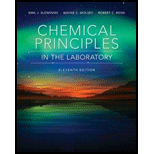
A 100-mL sample of hard water is titrated with the EDTA solution in Problem 2. The same amount of Mg2+ is added as previously, and the volume of EDTA required is 31.84 mL.
a. What volume of EDTA is used in titrating the Ca2+ in the hard water? _____________mL
b. How many moles of EDTA are there in that volume? _____________ moles
c. How many moles of Ca2+ are there in the 100 mL of water? _____________ moles
d. If the Ca2+ comes from CaCO3, how many moles of CaCO3 are there in one liter of the water? How many grams of CaCO3 are present per liter of the water? _____________ mol / L _____________ g / L
e. If 1 ppm CaCO3 = 1 mg per liter, what is the water hardness in ppm CaCO3? _____________ ppm CaCO3
Trending nowThis is a popular solution!

Chapter 28 Solutions
Chemical Principles in the Laboratory
- How many mL of 0.1200 M KSCN will be needed in the back titration after addition of 30 mL 0.110 M AgNO3 solution to 0.3655g KI dissolved in 100 mL water? a. 1.1951 mL b. 5.1919 mL c. 9.1519 mL d. 1.5911 mLarrow_forwardA2 ____ forms complex with EDTA ____ requires a second titrant for back-titration a. none of the above b. volhard c. mohr d. fajanarrow_forwardpH Titration Curve for titrating 64.4 mL of Nitric Acid with 0.798 mol/L Aqueous Potassium Hydroxide The volume of titrant used to reach the equivalence point for the titration is _____ mL. (Record your 3-digit answer)b. The pH at the equivalence point for the tittation is ______ c. An appropriate indicator to use is ______At the start of the titration, the indicator colour would be _____and at the endpoint of the reaction the indicator colour would be _____. d. The concentration of the nitric acid solution analyzed in this titration is calculated to be _____ mol/L. (Record your answer with the correct number of significant digits)arrow_forward
- Chemistry written by hand. In titration of 50 ml 0.1 M Mn2+ with 0.01 M EDTA (pH = 7), what is pMn2+ when 100 ml EDTA is added? a.7 b.11 c.9 d.15 e.8arrow_forwardA student titrated a 25.00 mL sample of water with 0.0200 M EDTA. The titration required 20.40 mL of EDTA. Calculate the ppm hardness in the water samplearrow_forward20. Assume you are using 0.1 M EDTA to titrate a 0.2 M Ca2t solution (25 mL) at pH 10.0. W molarity of free Ca* ions in the solution after 50 mL of the EDTA is added? K=5.0X101º. A. 2.11 X 106 M B. 8.16 X 10 M C. 4.97 X 106 M D. 8.36 X 10 6 Marrow_forward
- When Br2 dissolves in hexane, the hexane layer is ____________. Orange Yellow Purple Colorlessarrow_forwardConsider the titration of 50.0 mL of 0.0500 M HONH2 (a weak base; Kb = 1.10e-08) with 0.100 M HI. Calculate the pH after volume of titrant have been added: 42.5 mLpH = ___________arrow_forwardQuestion 4. Calculate the pCa vs. EDTA titration curve for 50.0 mL of 0.0060 M Ca2+ being titrated with 0.0150 M EDTA in a solution buffered to a constant pH of 10.00. a. After the addition of 0.00 mL b. After the addition of 0.00 mL c. After the addition of 26.00 mL. Attach File Browse Local Files: MOarrow_forward
- Using the graph given, which metal can be titrated better with EDTA? A. Fe3 +B. Fe2 +C. Ca2 +D. Hg2 +arrow_forwarda. A deepwell water sample of 100 mL was titrated with 0.010 M EDTA at pH 10 ( with Mg-EDTA pH 10 buffer reagent) and consumed 31 mL. Calculate the Total Hardness of the water sample as mg CaCO3. b. A deepwell water sample of 100 mL was titrated with 0.010 M EDTA at pH 12 and consumed 31 mL. Calculate the Calcium content of the water sample in mg/L.arrow_forward10. 10 mL of a river water sample containing an unknown concentration of Cu2+ is titrated with 0.1 mM EDTA. 20 mL EDTA solution is used to reach the equivalence point. What is the concentration of Cu2+ in this sample? A. 0.1 mM B. 0.2 mM C. 0.4 mM D. 0.6 mM 11. Citric acid is a triprotic acid found in many foods. If 100.0 mL 0.100 M citric acid is titrated with 0.500 M NaOH, how many mL of base will be required to reach the final (the third) equivalence point? A. 60.0 mL B. 20.0 mL C. 100.0 mL D. 300.0 mL compound tanning only solve compound 12. Which of the following titrations will have a basic pH at the equivalence point? (anotolg To A. CH3COOH (acetic acid) titrated with KOH B. HNO3 (nitric acid) titrated with KOH C. CIO (hypochlorite anion) titrated with HCl D. HC1 (hydrochloric acid) titrated with NaOH A. 7.54 B. 7.00 C. 4.65 D. 2.90 A.21 sanschoude 856-Om. ons na ritiw trgil etims Tozel A at waslaidi vd boob orq mn 003 D of infrared f 13. 50.0 mL of 0.100 hypochlorous acid…arrow_forward
 ChemistryChemistryISBN:9781305957404Author:Steven S. Zumdahl, Susan A. Zumdahl, Donald J. DeCostePublisher:Cengage Learning
ChemistryChemistryISBN:9781305957404Author:Steven S. Zumdahl, Susan A. Zumdahl, Donald J. DeCostePublisher:Cengage Learning ChemistryChemistryISBN:9781259911156Author:Raymond Chang Dr., Jason Overby ProfessorPublisher:McGraw-Hill Education
ChemistryChemistryISBN:9781259911156Author:Raymond Chang Dr., Jason Overby ProfessorPublisher:McGraw-Hill Education Principles of Instrumental AnalysisChemistryISBN:9781305577213Author:Douglas A. Skoog, F. James Holler, Stanley R. CrouchPublisher:Cengage Learning
Principles of Instrumental AnalysisChemistryISBN:9781305577213Author:Douglas A. Skoog, F. James Holler, Stanley R. CrouchPublisher:Cengage Learning Organic ChemistryChemistryISBN:9780078021558Author:Janice Gorzynski Smith Dr.Publisher:McGraw-Hill Education
Organic ChemistryChemistryISBN:9780078021558Author:Janice Gorzynski Smith Dr.Publisher:McGraw-Hill Education Chemistry: Principles and ReactionsChemistryISBN:9781305079373Author:William L. Masterton, Cecile N. HurleyPublisher:Cengage Learning
Chemistry: Principles and ReactionsChemistryISBN:9781305079373Author:William L. Masterton, Cecile N. HurleyPublisher:Cengage Learning Elementary Principles of Chemical Processes, Bind...ChemistryISBN:9781118431221Author:Richard M. Felder, Ronald W. Rousseau, Lisa G. BullardPublisher:WILEY
Elementary Principles of Chemical Processes, Bind...ChemistryISBN:9781118431221Author:Richard M. Felder, Ronald W. Rousseau, Lisa G. BullardPublisher:WILEY





